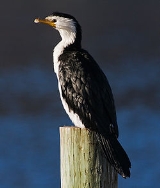
Little Pied Cormorant
Encyclopedia
The Little Pied Cormorant, Little Shag or Kawaupaka (Microcarbo melanoleucos) is a common Australasia
n waterbird, found around the coasts, islands, estuaries
, and inland waters of Australia, New Guinea
, New Zealand, Malaysia, and Indonesia
, and around the islands of the south-western Pacific and the sub-Antarctic. It is a small short-billed cormorant usually black above and white below with a yellow bill and small crest, although a mostly black white-throated form predominates in New Zealand. Three subspecies are recognised. Until recently most authorities referred to this species as Phalacrocorax melanoleucus.
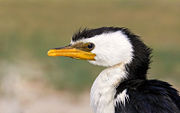
The Little Pied Cormorant was originally described by French naturalist Louis Jean Pierre Vieillot
in 1817. Its specific epithet is derived from the Ancient Greek
words melano- "black", and leukos "white". In 1931, American ornithologist James Lee Peters
was the first to consider this in a separate genus along with the Pygmy Cormorant
(M. pygmaeus), Little Cormorant (M. niger), and the Long-tailed Cormorant
(M. africanus). Since then, molecular work by Sibley and Ahlquist showed the Little Pied and Long-tailed Cormorants formed a group which had diverged early on from other cormorants. This group of "micro-cormorants" assumed the genus name Microcarbo
, initially described by French naturalist Charles Lucien Bonaparte
in 1855. The generic name is derived from the Ancient Greek mikros "small", and Latin
carbo "black". However, most older authorities refer to this species as Phalacrocorax melanoleucus.
Three subspecies are commonly recognised:
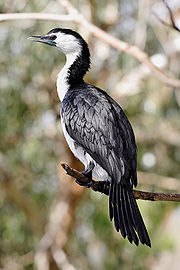
The pied form is glossy black above with white face, underparts and thighs. The bill and bare skin around the face are yellow. In both forms the legs and feet are black. The pied form is rare in New Zealand, and is most common there in Northland, where it makes up one in every four birds or so.
Chicks have dark brown down, with pied morph having patches of paler down. Immature birds are a dull blackish brown, with pied morph birds having paler underparts.
The Little Pied Cormorant makes a low cooing during courtship.
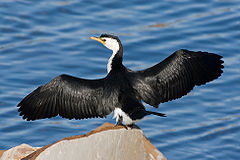
s. In New Zealand waters it is most often seen preying on the local flounder
and other small flatfish
. Eels and insect larvae are also consumed. These are brought to the surface to be swallowed: the bird will sometimes put a fish down on the surface of the water in order to re-orient it and swallow it head first. Because of this habit, they suffer some kleptoparasitism
from Red-billed Gull
s.
, giving them a matte white coated appearance. They become increasingly stained with feces, as does the nest, over the duration of the breeding season.
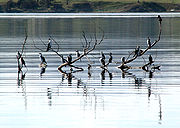
Australasia
Australasia is a region of Oceania comprising Australia, New Zealand, the island of New Guinea, and neighbouring islands in the Pacific Ocean. The term was coined by Charles de Brosses in Histoire des navigations aux terres australes...
n waterbird, found around the coasts, islands, estuaries
Estuary
An estuary is a partly enclosed coastal body of water with one or more rivers or streams flowing into it, and with a free connection to the open sea....
, and inland waters of Australia, New Guinea
New Guinea
New Guinea is the world's second largest island, after Greenland, covering a land area of 786,000 km2. Located in the southwest Pacific Ocean, it lies geographically to the east of the Malay Archipelago, with which it is sometimes included as part of a greater Indo-Australian Archipelago...
, New Zealand, Malaysia, and Indonesia
Indonesia
Indonesia , officially the Republic of Indonesia , is a country in Southeast Asia and Oceania. Indonesia is an archipelago comprising approximately 13,000 islands. It has 33 provinces with over 238 million people, and is the world's fourth most populous country. Indonesia is a republic, with an...
, and around the islands of the south-western Pacific and the sub-Antarctic. It is a small short-billed cormorant usually black above and white below with a yellow bill and small crest, although a mostly black white-throated form predominates in New Zealand. Three subspecies are recognised. Until recently most authorities referred to this species as Phalacrocorax melanoleucus.

Taxonomy
The species is known as the Little Pied Cormorant in Australia, and as the Little Shag or by the Māori name of Kawaupaka in New Zealand. The term White-throated Shag is also reserved for the melanistic form there.The Little Pied Cormorant was originally described by French naturalist Louis Jean Pierre Vieillot
Louis Jean Pierre Vieillot
Louis Jean Pierre Vieillot was a French ornithologist.Vieillot described a large number of birds for the first time, especially those he encountered during the time he spent in the West Indies and North America, and 26 genera established by him are still in use...
in 1817. Its specific epithet is derived from the Ancient Greek
Ancient Greek
Ancient Greek is the stage of the Greek language in the periods spanning the times c. 9th–6th centuries BC, , c. 5th–4th centuries BC , and the c. 3rd century BC – 6th century AD of ancient Greece and the ancient world; being predated in the 2nd millennium BC by Mycenaean Greek...
words melano- "black", and leukos "white". In 1931, American ornithologist James Lee Peters
James Lee Peters
James Lee Peters was an American ornithologist.Peters was Curator of Birds at the Museum of Comparative Zoology, at Harvard University...
was the first to consider this in a separate genus along with the Pygmy Cormorant
Pygmy Cormorant
The Pygmy Cormorant is a member of the cormorant family of seabirds. It breeds in southeastern Europe and southwestern Asia. It is partially migratory, with northern populations wintering further south, mostly within in its breeding range...
(M. pygmaeus), Little Cormorant (M. niger), and the Long-tailed Cormorant
Long-tailed Cormorant
The Reed Cormorant , also known as the Long-tailed Cormorant, is a bird in the cormorant family Phalacrocoracidae. It breeds in much of Africa south of the Sahara, and Madagascar. It is resident but undertakes some seasonal movements.This is a common and widespread species, and is not considered to...
(M. africanus). Since then, molecular work by Sibley and Ahlquist showed the Little Pied and Long-tailed Cormorants formed a group which had diverged early on from other cormorants. This group of "micro-cormorants" assumed the genus name Microcarbo
Microcarbo
Microcarbo is a genus of fish-eating birds, known as cormorants, of the family Phalacrocoracidae. Until recently, this genus was often subsumed within Phalacrocorax....
, initially described by French naturalist Charles Lucien Bonaparte
Charles Lucien Bonaparte
Charles Lucien Jules Laurent Bonaparte, 2nd Prince of Canino and Musignano was a French naturalist and ornithologist.-Biography:...
in 1855. The generic name is derived from the Ancient Greek mikros "small", and Latin
Latin
Latin is an Italic language originally spoken in Latium and Ancient Rome. It, along with most European languages, is a descendant of the ancient Proto-Indo-European language. Although it is considered a dead language, a number of scholars and members of the Christian clergy speak it fluently, and...
carbo "black". However, most older authorities refer to this species as Phalacrocorax melanoleucus.
Three subspecies are commonly recognised:
- M. m. melanoleucos. Resident throughout the species range except in New Zealand and the sub-Antarctic islands
- M. m. brevicauda Mayr 1931. Endemic to Rennell IslandRennell IslandRennell Island, locally known as Mungava, is the main island of two inhabited islands that make up the Rennell and Bellona Province in the Solomon Islands. Rennell Island has a land area of that is about long and wide. It is the second largest raised coral atoll in the world with the largest lake...
, in the Solomon IslandsSolomon IslandsSolomon Islands is a sovereign state in Oceania, east of Papua New Guinea, consisting of nearly one thousand islands. It covers a land mass of . The capital, Honiara, is located on the island of Guadalcanal... - M. m. brevirostris Gould 1837 (Little Shag). Resident throughout New Zealand and regularly seen on sub-Antarctic islands; has bred on Campbell IslandCampbell Island, New ZealandCampbell Island is a remote, subantarctic island of New Zealand and the main island of the Campbell Island group. It covers of the group's , and is surrounded by numerous stacks, rocks and islets like Dent Island, Folly Island , Isle de Jeanette Marie, and Jacquemart Island, the latter being the...
. Some authorities treat this form as a distinct species, P. brevirostris.

Description
The Little Pied Cormorant is a small cormorant measuring 56–58 cm (22–23 in) with a shorter 3 cm (1.25 in) bill and longer tail than the Little Black Cormorant; it has a small black crest. It is found in two morphs in New Zealand. Subspecies melanoleucos and brevicauda are found only in a pied morph, black (with a slight green tinge) above and white beneath. This is also found in subspecies brevirostris, but in this form the melanistic morph is much more common. In this form the entire plumage is black with a greenish tinge except for the sides of the head, chin, throat and upper neck; the bill is yellow with black on top. Intermediate forms are also found.The pied form is glossy black above with white face, underparts and thighs. The bill and bare skin around the face are yellow. In both forms the legs and feet are black. The pied form is rare in New Zealand, and is most common there in Northland, where it makes up one in every four birds or so.
Chicks have dark brown down, with pied morph having patches of paler down. Immature birds are a dull blackish brown, with pied morph birds having paler underparts.
The Little Pied Cormorant makes a low cooing during courtship.

Distribution and habitat
The species ranges across New Zealand, from Steward Island to Northland, and across mainland Australia (although not in the arid interior of the west of the country) and Tasmania and Indonesia. Widespread and common, it lives near bodies of water such as swamps, lakes, lagoons, estuaries and the coastline.Feeding
The Little Pied Cormorant is a benthic feeder, i.e. it finds its prey on the sea floor. It is a solitary feeder, normally diving in relatively shallow water, often near the shore. Dive times are short, around 15 to 20 seconds, with recovery times on the surface of 5 to 10 seconds unless prey are being swallowed. It takes a variety of fish prey but an unusually high proportion (nearly 30% by weight on average, and up to 80% in some individuals) of crustaceanCrustacean
Crustaceans form a very large group of arthropods, usually treated as a subphylum, which includes such familiar animals as crabs, lobsters, crayfish, shrimp, krill and barnacles. The 50,000 described species range in size from Stygotantulus stocki at , to the Japanese spider crab with a leg span...
s. In New Zealand waters it is most often seen preying on the local flounder
Flounder
The flounder is an ocean-dwelling flatfish species that is found in coastal lagoons and estuaries of the Northern Atlantic and Pacific Oceans.-Taxonomy:There are a number of geographical and taxonomical species to which flounder belong.*Western Atlantic...
and other small flatfish
Flatfish
The flatfish are an order of ray-finned fish, also called the Heterosomata, sometimes classified as a suborder of Perciformes. In many species, both eyes lie on one side of the head, one or the other migrating through and around the head during development...
. Eels and insect larvae are also consumed. These are brought to the surface to be swallowed: the bird will sometimes put a fish down on the surface of the water in order to re-orient it and swallow it head first. Because of this habit, they suffer some kleptoparasitism
Kleptoparasitism
Kleptoparasitism or cleptoparasitism is a form of feeding in which one animal takes prey or other food from another that has caught, collected, or otherwise prepared the food, including stored food...
from Red-billed Gull
Red-billed Gull
The Red-billed Gull , once also known as the Mackerel Gull, is a native of New Zealand, being found throughout the country and on outlying islands including the Chatham Islands and Sub-antarctic islands.The Māori name of this species is Tarapunga or Akiaki...
s.
Breeding
Breeding occurs once a year in spring or early summer in southern areas of its range (southern Australia and New Zealand), and after the monsoon in tropical regions. The nest is a platform built of branches and sticks, often still green with leaves in the forks of trees, usually eucalypts that are standing in water. Nests are often located near other waterbirds such as other cormorants, herons, ibis or spoonbills. Four or five pale blue oval eggs measuring 46 x 31 mm are laid. The eggs are covered with a thin layer of limeLime (mineral)
Lime is a general term for calcium-containing inorganic materials, in which carbonates, oxides and hydroxides predominate. Strictly speaking, lime is calcium oxide or calcium hydroxide. It is also the name for a single mineral of the CaO composition, occurring very rarely...
, giving them a matte white coated appearance. They become increasingly stained with feces, as does the nest, over the duration of the breeding season.


